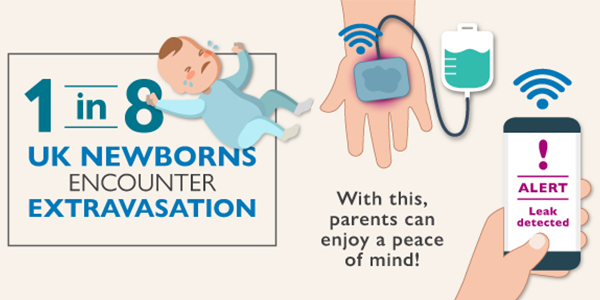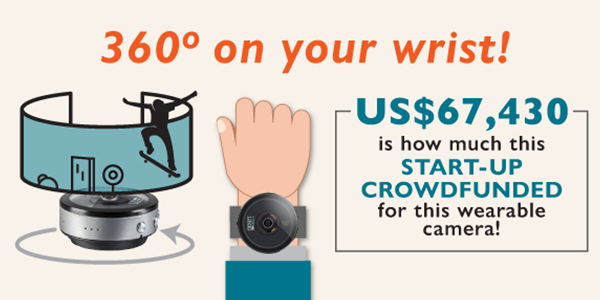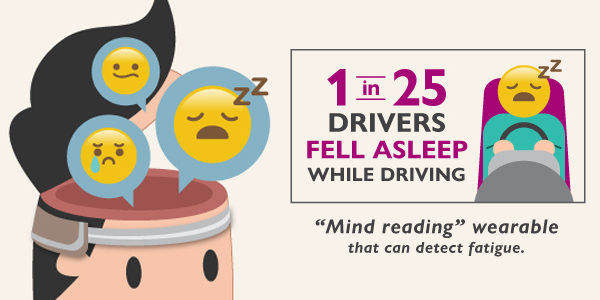INNOVATE
Singapore's future wearables beyond the Smart Watch
With a current market value of S$20 billion and an expected compound annual growth rate (CAGR) of 16.4% by 2019- the global wearables industry is a bright spot within the tech world.
Although large global brands such as Apple- Garmin and Samsung dominate wearable technology- there is still a vast and untapped potential beyond fitness and lifestyle applications.
In Singapore- researchers are already developing wearables that have other applications- such as for healthcare- brain training and social adventure photography. The 360-degree cameras on your wrist and a headband that knows when you are tired may soon be a reality- thanks to inventive researchers in Singapore.
Leaky drips- beware!

Intravenous (IV) drips are routinely attached to hospital patients to administer necessary medications and fluids.
When IV needles leak their contents into the surrounding tissues- they can cause serious injuries such as skin blisters- tissue deaths- limb deformity and limb impairment. This condition is known as extravasation.
Newborns and young children are at a higher risk of extravasation as their veins are smaller and signs of extravasation- such as swelling- are harder to detect in them.
There are currently no effective medical devices in the market to detect extravasations- especially for ‘slow drips’ that deliver less than 50ml of fluids per hour.
To solve this problem- researchers from A*STAR’s Institute of Microelectronics (IME) have developed an adhesive sensor patch that detects ‘micro-swelling’ on the surface of the skin near an IV needle.
Thin and portable- the patch can detect the leakage of as little as 2ml of fluid. The patch sends a signal to a receiver- which then relays the message to the patient’s clinician via a mobile application in real time- allowing for immediate medical intervention.
The patch has been successfully tested in lab experiments and will undergo more comprehensive clinical trials soon. It is expected to enter the market within the next 2 years.
Capture memories in panorama

Hands-free cameras are in high demand by sports and adventure enthusiasts who want to capture all the action.
However- some head-mounted cameras have a limited field of view. Local optics start-up- Spacemap- may have the solution.
Spacemap enlisted the help of Randy Hipona- an A*STAR IME research engineer who was seconded under A*STAR’s T-Up programme. Hipona worked on the camera’s electronic parts and the baseline hardware before putting the two together.
The result of their collaboration is Beoncam- an “always on” wrist camera which can take 360-degree panoramic shots.
The camera itself has a 190-degree hemispheric field of view. However- two Beoncam units can be used simultaneously- while its companion smartphone app stitches together these separate shots.
Beoncam- equipped with a 5MP waterproof sensor- Bluetooth and Wi-Fi – is capable of storing 5-000 photos or 4 hours of video footage. It also lasts up to 5 days on a single charge.
Beoncam was well-received when it debuted at the CES 2017 trade show in Las Vegas in January. A month later- Spacemap launched a fundraising campaign on crowdfunding platform indiegogo- where the Beoncam hit twice its original US$30-000 funding target within two months. It currently retails for US$199 and will be available on Singaporean shores by the end of 2017.
Mind-reading wearable!

As the most complex organ in the human body- the brain plays a significant impact on our daily activities.
However- we may not be aware of the various states of our brain – such as a declining attention span or hormonal-based mood swings – until they reach critical levels.
To enable us to understand our brain health better- researchers at A*STAR’s Institute of Infocomm Research (I2R) have developed a wireless headband that measures neurophysiological signals.
Known as a Wearable Neural Sensing Platform (IWENS)- the headband is fitted with high-performance neural sensing technology that can be programmed to detect and measure brain states such as attention- emotions- fatigue and anxiety.
The headband makes use of integrated high-performance electroencephalography (EEG) and photoplethysmography (PPG) sensing to measure- monitor and improve specific brain functions.
Gap-funded by A*STAR’s commercialisation arm ETPL- IWENS has the ability to measure- monitor and improve specific brain functions- which makes it potentially applicable in the areas of attention training- wellness tracking- personal safety and security- as well as entertainment and gaming.
For instance- the headband can be programmed to measure fatigue levels in drivers- and release scents when it detects that the driver is tired to alert them.
Currently a working prototype- IWENS is available for commercialization and licensing by interested parties.
A glance of what’s to come
These Singapore-made wearable tech inventions point to an exciting future. Soon- powerful computing can literally be in your hand and help improve our well-being beyond calorie-counting.
To find out how you can license our technologies or partner with A*STAR- email us at tech-offer@accelerate.tech.
Was the article helpful?
A*STAR celebrates International Women's Day

From groundbreaking discoveries to cutting-edge research, our researchers are empowering the next generation of female science, technology, engineering and mathematics (STEM) leaders.
Get inspired by our #WomeninSTEM
